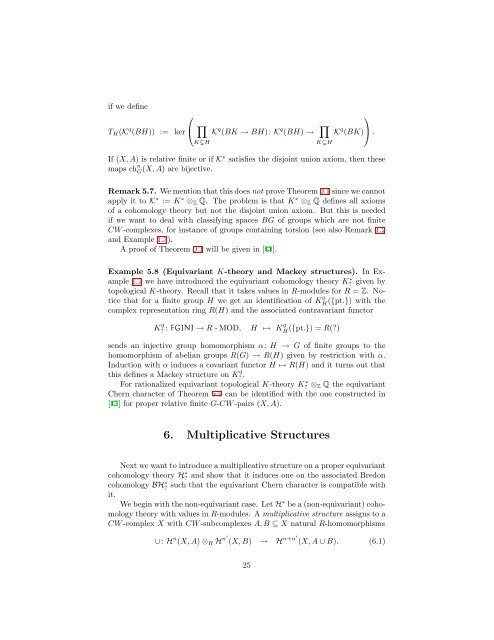Equivariant Cohomological Chern Characters
Equivariant Cohomological Chern Characters
Equivariant Cohomological Chern Characters
You also want an ePaper? Increase the reach of your titles
YUMPU automatically turns print PDFs into web optimized ePapers that Google loves.
if we defineT H (K q (BH)) :=⎛⎞ker ⎝ ∏K q (BK → BH): K q (BH) → ∏K q (BK) ⎠ .KHKHIf (X, A) is relative finite or if K ∗ satisfies the disjoint union axiom, then thesemaps ch n G(X, A) are bijective.Remark 5.7. We mention that this does not prove Theorem 0.1 since we cannotapply it to K ∗ := K ∗ ⊗ Z Q. The problem is that K ∗ ⊗ Z Q defines all axiomsof a cohomology theory but not the disjoint union axiom. But this is neededif we want to deal with classifying spaces BG of groups which are not finiteCW -complexes, for instance of groups containing torsion (see also Remark 1.2and Example 1.3).A proof of Theorem 0.1 will be given in [11].Example 5.8 (<strong>Equivariant</strong> K-theory and Mackey structures). In Example1.7 we have introduced the equivariant cohomology theory K? ∗ given bytopological K-theory. Recall that it takes values in R-modules for R = Z. Noticethat for a finite group H we get an identification of KH 0 ({pt.}) with thecomplex representation ring R(H) and the associated contravariant functorK q ?: FGINJ → R - MOD, H↦→ Kq H({pt.}) = R(?)sends an injective group homomorphism α: H → G of finite groups to thehomomorphism of abelian groups R(G) → R(H) given by restriction with α.Induction with α induces a covariant functor H ↦→ R(H) and it turns out thatthis defines a Mackey structure on K q ? .For rationalized equivariant topological K-theory K ∗ ? ⊗ Z Q the equivariant<strong>Chern</strong> character of Theorem 5.5 can be identified with the one constructed in[12] for proper relative finite G-CW -pairs (X, A).6. Multiplicative StructuresNext we want to introduce a multiplicative structure on a proper equivariantcohomology theory H? ∗ and show that it induces one on the associated Bredoncohomology BH? ∗ such that the equivariant <strong>Chern</strong> character is compatible withit.We begin with the non-equivariant case. Let H ∗ be a (non-equivariant) cohomologytheory with values in R-modules. A multiplicative structure assigns to aCW -complex X with CW -subcomplexes A, B ⊆ X natural R-homomorphisms∪: H n (X, A) ⊗ R H n′ (X, B) → H n+n′ (X, A ∪ B). (6.1)25
















